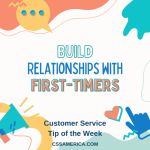
Argue with the title if you want – “Nobody decides MY fate!” or “I’m in control of my own life.” or “Our nutty CEO decides our company’s fate.”
Feel free to make whatever argument you’d like to make (and I’m sure many are valid), but here’s my perspective. I’ve worked with local government organizations where community complaints about a particular agency cost the leader his job and cost the municipality millions of dollars in rework that also served as repentance.
I’ve seen professional sports clubs where the dwindling attendance caused executives to lose jobs, or the teams spent millions more than in the past to acquire new fans through marketing, advertising, and sales efforts.
There are so many healthcare organizations today whose CEO is seeing that their government reimbursement is being impacted more and more by the results of patient satisfaction surveys.
In other words, the customer’s voice matters. . .BIG TIME!
That means that we have to listen when they care enough to complain. We have to have a process of frequently soliciting feedback to understand their feelings, perceptions, plans, and suggestions. We have to ask at the end of conversations about experiences so we can fix issues on the spot, and so we can find out what they really liked.
The customer deciding our company’s fate means that once we have them, we have to create a culture that seeks to serve. We have to view them for their lifetime value, not transactional amount. We have to nurture the long-term relationship rather than focusing solely on the task at hand. And we have to become so vital to them, so trusted by them, so much in relationship with them, or so pleasing in their experience with us that – when the fateful decision is made – they decide to stay and grow with us.
In other words, if everyone in the organization truly believes that the customer decides the company’s fate, how would we be different than we are today?
Ask the question, and then live the answer.
Signup for FREE Tips! Contact Us More Resources for You Visit Our Home Page





















